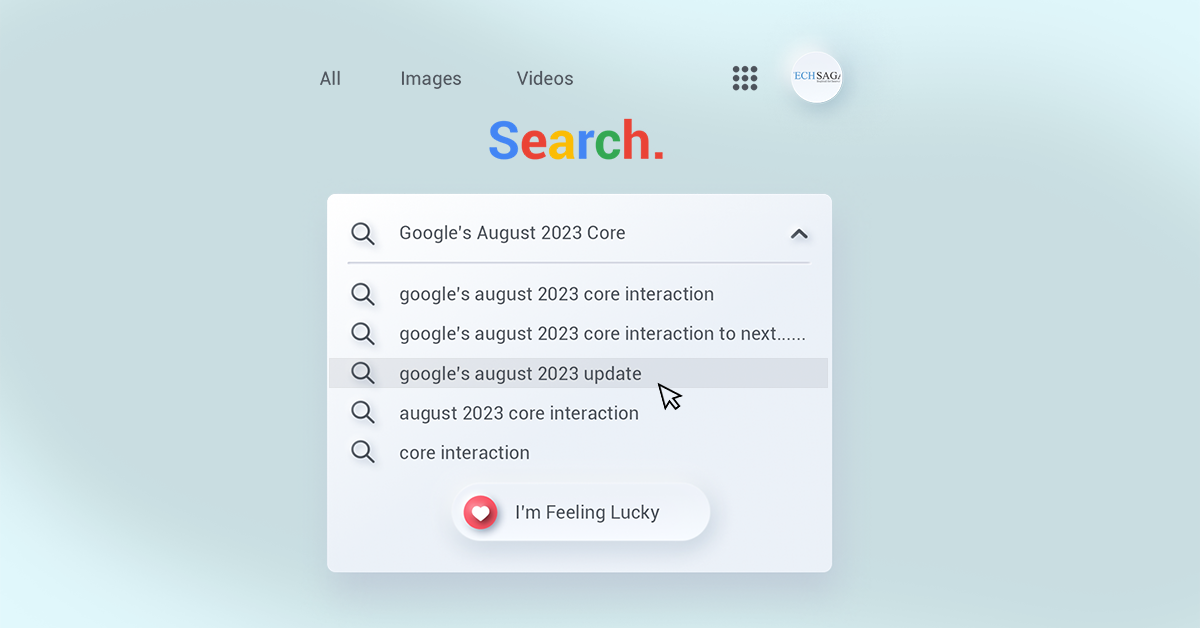Team Techsaga
Gain valuable insights and stay updated with the latest innovations through our engaging blog. Explore trends, technology advancements, and expert opinions to navigate the ever-evolving world of IT.
Google’s August 2023 Core Update Interaction to Next Paint INP
Google has rolled out its core search update for August 2023, i.e.Core Web Vitals updates with the process expected to span several weeks. The tech giant confirmed the commencement of the August 2023 core algorithm change. Moreover, updates on the ranking release history page will be made once the deployment is entirely done. Google’s advice for those noticing ranking drops or keyword fluctuations is to enhance website quality over seeking technical solutions.
To provide users with the most accurate and trustworthy information, Google consistently issues these core updates.
Though not aiming at specific websites or pages, core updates can enhance the visibility of previously lower-ranking pages. Conversely, some high-ranking pages might experience a dip.
Implications of Core Updates:
Websites may experience positive, negative, or no shifts at all following a core update.
Google emphasizes that a dip in website performance post-update doesn’t necessarily point to problems on the site. Therefore, such decreases might stem from changes implemented by the core update rather than issues with a site’s content or layout.
Google’s advice for those noticing ranking drops or keyword fluctuations is to enhance website quality over seeking technical solutions.
Steps to Bounce Back:
For optimising search performance post-core update, Google suggests:
- Thoroughly review underperforming pages.
- Understand search queries directing users to those pages.
Contrast your content against Google’s help page queries.
- This will identify gaps in your content regarding user queries. Use this insight to refine your content according to users’ needs.
However, Google notes that there’s no surefire promise that these improvements will foster recovery. Also, no page has a permanent or promised spot in Google’s search outcomes.
Recovery Duration-
Post-core update, It might take pages a few months to regain lost rankings, provided they merit it.
Yet, with Google perpetually refining its algorithms, interim updates between core changes can boost pages that have made amendments.
Google’s Recent Core Web Vitals Update: Enhancing Interaction to Next Paint (INP):
Discover the evolving landscape of Core Web Vitals and understand the measures to excel in Google’s novel page experience metric: Interaction to Next Paint (INP).
So, what does it take to achieve a top rank on Google?
The answer is simple: Produce High-Quality Content catering to your audience-
1. However, the quality of the user experience on your website is a factor Google also pays heed to.
2. Over recent times, Google has redefined the parameters that determine page experience and its influence on rankings.
3. With the inception of Core Web Metrics, Google has continually refined its measurement techniques for better alignment with actual user experience.
4. And now, with the unveiling of the INP metric, we see the most significant shift in Core Web Vitals since its inception.
5. So, what steps should you undertake before INP becomes an essential ranking element?
6. This article deciphers the new metric by Google and guides you towards its optimization.
Understanding Core Web Vitals & Their Evolutions:
Introduced as a ranking determinant in June 2021, Core Web Vitals (CWV) consist of three user-centric metrics: Largest Contentful Paint, Cumulative Layout Shift, and First Input Delay.
- Largest Contentful Paint: Speed of Main page content appearance? i.e., How fast does the main page content appear?
- Cumulative Layout Shift: Post-load page layout stability? i.e., Is the page layout stable once it has been loaded?
- First Input Delay: User input responsiveness speed? i.e., How fast does the website react to user input?
However, Interaction to Next Paint (INP) will replace the First Input Delay in March 2024.
What is Interaction To Next Paint(INP):

The INP metric offers insights into the latency users face while engaging with your site.
Specifically, INP calculates the duration from when a user takes an action (e.g., clicking) to the subsequent visible site update.
For instance, a 500 milliseconds INP value implies a half-second delay after a button press before the site updates, reflecting the time utilised by the browser for executing site codes and rendering the update.
Transitioning from First Input Delay to INP: Why?
Google realised the limitations of the First Input Delay metric in accurately detecting subpar user experiences.
The newer INP metric offers two distinct advantages-
- It captures the entire delay from user action to visible site update, whereas First Input Delay only considers a portion.
- INP evaluates all site interactions and typically highlights the most prolonged delay, whereas the First Input Delay focuses solely on the initial interaction.
Ideal INP Values-
Aiming for an INP value under 200 milliseconds ensures adherence to Google’s Core Web Vitals standards.
Interestingly, while 93% of mobile websites met the First Input Delay benchmark effortlessly, only 64% presently meet the INP standard.
Free tools like PageSpeed Insights or DebugBear can help gauge your site’s performance.
Factors Contributing to Sluggish INP Scores:
Predominantly, ongoing CPU activity that hinders browser updates results in lagging INP scores.
The composite INP score encompasses:
- Input Delay: Time from user action to site response.
- Processing Time: Duration for code execution post-user interaction.
- Presentation Delay: Time taken by browsers to decide the visual display of new content.
Strategies for INP Optimization-
To identify which parts of your website need refinement, Google Search Console‘s Core Web Vitals report is a starting point.
The article explores four methods to pinpoint sluggish interactions:
- Utilizing the INP Debugger: A free tool by DebugBear to automatically highlight slow site elements.
- Employing Chrome DevTools: Detailed, manual insights into complex INP issues.
- Leveraging Lighthouse User Flows: Google’s tool for focused analysis on interaction delays.
- Addressing and Rectifying INP Issues: Collaboration with your development team to solve detected problems.
Simplifying the Process: Real User Monitoring (RUM):
RUM tools allow for real-time data collection, revealing the specifics of user interaction delays.
Using tools like DebugBear’s RUM product, you can:
- Automatically identify problematic page elements.
- Recognize commonly lagging elements.
- Implement required modifications.
By offering real-time insights, RUM aligns closely with Google’s metrics, which are derived from actual users. This makes tracking intricate user paths and interactions on different browsers and screen sizes feasible. However, employing RUM often involves utilising paid tools and embedding a code snippet on your site.
The Wayforward:
As the repercussions of the August 2023 core algorithm update unravel, it’s imperative for businesses and SEO experts to be patient, centre on enhancing website calibre, and sidestep hasty remedies. Therefore, important Components Of Technical SEO Need to be taken care of while doing SEO. It includes having up-to-date knowledge of Core Web Vitals, Google Search Console, Sitemaps, Largest Contentful Paint (LCP), Cumulative Layout Shift, First Input Delay, Interaction to Next Paint (INP), URL Inspection, Search Results, Discover, Page Experience, Mobile Usability, AMP, Breadcrumbs, Sitelink, Inspect any URL, Indexing, Performance, Search Console Insights.
In times of the digital revolution, everyone wants their websites to rank at the top of the SERPs of search engines. Here at Techsaga, we have expertise in providing IT software solutions along with Digital Marketing Services to help you reach at top of search results Contact Us Now!
TAG: Digital Marketing




